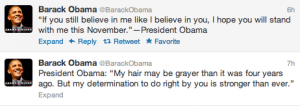Brands
Content Campaign ’12: Obama and Romney Offer Lessons on How Not to Tweet
As part of the Content Campaign ’12 Series, The Content Strategist examines the content published by the presidential campaigns as part of their strategy to win November’s general election.
Presidential candidates’ tweets can make waves online. They can also part water at the polls — that is, if they’re used effectively.
 According to John Parmelee, author of Politics and the Twitter Revolution: How Tweets Influence the Relationship between Political Leaders and the Public, interactive tweets breed political loyalty that can lead to political action.
According to John Parmelee, author of Politics and the Twitter Revolution: How Tweets Influence the Relationship between Political Leaders and the Public, interactive tweets breed political loyalty that can lead to political action.
“Political tweets are more influential on someone’s politics or political ideology than any other source,” Parmelee said, referring to a survey he conducted for his book last year.
Of the 426 political Twitter users (people over 18 who follow at least one political figure online) he surveyed, he found that what makes Twitter more powerful than other forms of candidate communication is the expectation of interaction.
 “The recurring theme is that people who follow political leaders on Twitter crave interaction,” Parmelee, a communications professor at the University of North Florida, said. “They don’t just want to be passive receivers; they want a two-way conversation with leaders.”
“The recurring theme is that people who follow political leaders on Twitter crave interaction,” Parmelee, a communications professor at the University of North Florida, said. “They don’t just want to be passive receivers; they want a two-way conversation with leaders.”
The tweets of the presidential campaigns are lacking in this regard, providing a telling example of what should be avoided for those attempting to create a loyal following. Of Obama and Romney‘s thousands of tweets, only a tiny portion have been interactive responses to other tweets.
“They’re mostly using it as one-way communication vehicle to shoot out little press releases and snide remarks and appeals for votes,” Parmelee said of the candidates. “They have flashes of interaction from time to time, but it’s still the exception, not the rule.”
Twitter’s format also makes politicians seem more accountable because it’s a direct and open communication channel. If you send an @mention, the candidates (or at least their staffers) will see it. Your followers also see the tweets. Unfortunately, for now, they’re seeing that the candidates aren’t tweeting back.
Obama, whose personal tweets are signed “BO,” is slightly better than Romney at interactivity on Twitter. He retweets tweets that mention his campaign positively (these are usually from his affiliated accounts) and encourages retweets, but that falls far short of a conversation.
 Neither candidate seems to be responding to questions or @mentions in a meaningful way — to clarify or answer a comment or question.
Neither candidate seems to be responding to questions or @mentions in a meaningful way — to clarify or answer a comment or question.
By not interacting, candidates miss the opportunity to satisfy constituents and, by extension, create good word of mouth. Word of mouth — on Twitter or otherwise — is one of the oldest and most successful ways of persuading people, Parmelee pointed out. If you can’t trust your friends or family’s judgement, whose can you trust?
What’s worse: The lack of interaction can make followers feel rejected.
“It’s not just about potentially losing that person or supporter,” Parmelee said. According to his research, “Negative word of mouth tweets travel a lot faster and farther than positive ones.”
Of course interactivity requires a lot of work, but if that sways peoples’ votes, it’s worth it. And fortunately for the candidates, being interactive doesn’t mean responding to every Twitter question or @ message.
 Parmelee, who also runs the politics and media blog The Wonky Professor, said the candidates should use a strategy that big brands leverage: gauging clout.
Parmelee, who also runs the politics and media blog The Wonky Professor, said the candidates should use a strategy that big brands leverage: gauging clout.
When deciding whom to respond to, it’s more effective (in the sense that more people will see it) if you respond to people who have a large, but more importantly, loyal Twitter following.
According to Parmelee, on Twitter, size doesn’t matter. It’s the quality of followers over quantity — a detail that could prove more important for Romney, who only has 800,000 Twitter followers compared to Obama’s 18 million.
“It doesn’t matter if a person has 100,000 followers,” Parmelee said. “If someone has half that but the followers are more loyal, they are more likely to do what is asked in a tweet.”
Those are big stakes when you’re asking for votes.
Get better at your job right now.
Read our monthly newsletter to master content marketing. It’s made for marketers, creators, and everyone in between.




